
Our Greek Courses in Greece
click below : - Athens
- Thessaloniki
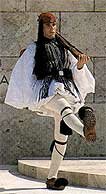 10.71 million 10.71 million
 National anthem National anthem
Greece's climate varies according to region.
The southern and central portions of the country experience the traditional Mediterranean climate of hot, dry summers and mild, wet winters. The continental climate of northern Greece is marked by colder winters.
There is also considerable regional variation in annual rainfall, with areas to the west of the Pindus Mountains receiving far more rain than those to the east. The Ionian island of Corfu (KÚrkira), located off the mainland's north-western coast, receives an average of 1,000 mm (40 in) of rain per year,
whereas the average annual rainfall in Athens in central Greece is 400 mm (16 in). Snow is common in the mountains.
The average January temperature in Athens is 10░ C /50░ F the July average is 28░ C/ 82░ F.
Greek
Electricity: 220V, 50 Hz
Weights & measures: metric
Euro
- For Canadians, please visit this web site. Travel information and advisory reports
- For others nationalities, please check with the Consulate or the embassy of the country you want to visit.
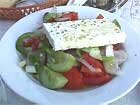
Prawns with Feta
Category: Prawn / Shrimp
Country: Greece
Ingredients...
2 lbs prawns
4 fl oz dry white wine
4 tbsps virgin olive oil
2 onions, finely sliced
3 cloves garlic, finely chopped
1 lb 2 oz tomatoes, peeled & chopped
2 tbsps parsley, finely chopped
salt and pepper
6 oz feta, crumbled
Instructions...
Put prawns and wine in a large saute pan over a high heat and cook covered for about 5 minutes.
Remove prawns with a slotted spoon. When they have cooled a little remove shells.
Add olive oil, onions and garlic to the prawns cooking liquid.
Cook, stirring over a medium heat until most of the liquid has evaporated.
Add the tomatoes and parsley. Simmer, covered, for 10 minutes then uncovered
for 20 - 30 minutes until you have a not too liquid sauce.
Add a little salt, plenty of pepper and the shelled prawns.
Mix well and put the mixture in 4 small dishes or ramekins. Sprinkle with the feta.
Bake in a preheated 220 C gas 7 oven for about 15 minutes, until the cheese has melted and begun to brown on top


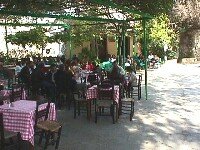
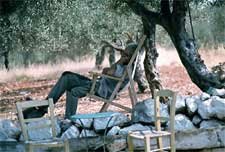



 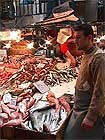
|
 |

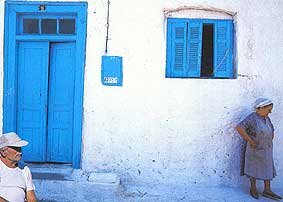
Greece (Greek Hellas), officially known as the
Hellenic Republic (EllinikÝ DimokratÝa),
country in south-eastern Europe, occupying the
southernmost part of the Balkan Peninsula.
Famed for the beauty of its landscape, Greece
is dominated by mountains and sea.
The Aegean, Mediterranean, and Ionian seas
constitute the country's eastern, southern,
and western borders, and no part of mainland
Greece is more than 100 km (60 mi) from the water.
Islands constitute about one-fifth of the country's land area.
Athens
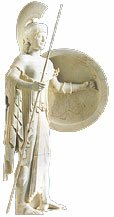
Peloponnese
The Peloponnese, Greece's southern peninsula,
is rich in history and scenically diverse.
Packed into its northeastern corner are the
ancient sites of Epidaurus, Corinth and Mycenae,
all easily reached from Nafplio. The ghostly, capacious Byzantine city of Mystras clambers up the slopes of
Mt Ta getos, its winding paths and stairways leading to deserted palaces and fresco-adorned churches.
Further south, you can explore the Mani, a region
of bleak mountains and barren landscapes
broken only by austere and imposing stone towers,
mostly abandoned but still standing sentinel
over the region. Other attractions in the region
include ancient Olympia, the beautiful medieval
town of Monemvasia and the thrilling Diakofto-Kalavryta rack-and-pinion railway, which rollercoasts its way
through the deep Voura´kos Gorge.
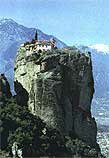 Meteora Meteora
The monasteries of Meteora,
in the province of Thessaly,
are one of the most extraordinary
sights in mainland Greece.
Built into and on top of huge
pinnacles of smooth rock with
cheese-like holes in it, the
monasteries provided monks
with peaceful havens from increasing bloodshed as the
Byzantine Empire waned at the end of the 14th century.
The earliest monasteries were reached
by climbing articulated removable ladders. Later,
windlasses were used so monks could be hauled
up in nets, a method used until the 1920s.
Apprehensive visitors enquiring how often the ropes
were replaced were told 'When the Lord lets them break'.
These days access to the monasteries is by steps
hewn into the rocks and the windlasses are used
only for hauling up provisions.
 Cyclades Cyclades
The Cycladic islands epitomise the postcard image of the Greek islands: dazzling white buildings are offset
by bright-blue church domes, while golden beaches meet an aquamarine sea. Some of the Cyclades, such as Mykonos,
Santorini, Paros and Ios, have vigorously embraced the tourist industry; others, such as Andros, Kea,
Serifos and Sikinos, are visited infrequently by foreigners but are favourites with holiday-makers from Athens.
Mykonos is the most expensive and heavily visited of all Greek islands. It has the most sophisticated nightlife
and is the undisputed gay capital of Greece. Barren, low-lying Mykonos would never win a Greek-island beauty contest,
but it does have superb (if crowded) beaches. The town is an enchanting warren of chic boutiques and
chimerical houses with brightly painted balconies draped in bougainvillea and clematis; it's too perfect for some tastes.
Santorini (also known as Thira) is regarded by many as the most spectacular of the Greek islands.
Thousands of tourists come every year to gape at the sea-filled caldera, a vestige of what was probably
the world's largest volcanic eruption, ever. Despite the crowds who visit in summer, Santorini's weirdness,
apparent in its black-sand beaches and mighty cliffs, holds a distinct allure.
If you want to escape the tourist hordes, Sikinos, Anafi and the tiny islands to the east of Naxos offer some respite.
 Dodecanese Islands Dodecanese Islands
Strung along the coast of western Turkey, the Dodecanese archipelago is much closer to Asia Minor than to mainland Greece.
Because of their strategic and vulnerable position, these islands have been subjected to an even greater catalogue of
invasions and occupations than the rest of Greece - Egyptians, the Knights of St John, Turks and Italians have all done
their bit as conquerors. Rhodes is the largest of the Dodecanese islands and its town is the largest inhabited medieval
settlement in Europe. The Avenue of the Knights is lined with magnificent medieval buildings, the most impressive of
which is the Palace of the Grand Masters, restored, but never used, as a holiday home for Mussolini.
The imposing Acropolis of Lindos shares its rocky outcrop with a Crusader castle above winding streets with whitewashed,
elaborately decorated houses.
Other popular islands in the Dodecanese include Kos, Symi and Patmos. The untouristy islands of Lipsi and Tilos have
fantastic beaches without large crowds, and the far-flung Agathonisi, Kastellorizo and Kassos are great places
to experience traditional island life. Kassos is a rocky little place just south of Karpathos, populated only
by prickly-pear trees, sparse olive and fig trees, dry-stone walls, sheep and goats.
If you tell Karpathians you're off to Kassos, they'll tell you to take your knitting.
Ionian Islands
The Ionian group consists of seven main islands: Corfu (also known as Kerkyra), Paxoi, Kefallonia, Zakynthos,
Ithaki, Lefkada and Kythira. Strung along the west coast of Greece, the Ionian islands are the only group not
in the Aegean, and in many ways they are more reminiscent of their close neighbour, Italy. Apart from tiny Meganisi,
none are 'undiscovered', although, as with all Greek islands, anyone who forays into their hinterlands will
be rewarded with the delights of unspoilt villages. Corfu, with its beguiling landscape of vibrant wildflowers
and slender cypress trees rising out of shimmering olive groves, is considered by many to be the most beautiful
of the Greek islands.
Northeastern Aegean Islands
There are seven major islands in the northeastern group: Samos, Chios, Ikaria, Lesvos, Limnos, Samothraki and Thasos.
Huge distances separate them, so island hopping is not as easy as it is within the Cyclades and Dodecanese.
Most of these islands are large and have very distinctive characters. Samos, the birthplace of philosopher
and mathematician Pythagoras, is lush and humid with mountains skirted by pine, sycamore and oak-forested hills.
Egg-shaped Samothraki has dramatic natural attributes, culminating in the mighty peak of Mt Fengari (1611m)
which looms over valleys of massive gnarled oak and plane trees, thick forests of olive trees and damp dark
glades where waterfalls plunge into deep icy pools.
Sporades
There are four inhabited islands in this mountainous and pine-forested northern archipelago: Skiathos, Skopelos,
Alonnisos and Skyros. They are all heavily tourist and expensive. People go to Skiathos for the exquisite beaches
and the nightlife; if you're there for anything else,
you'll probably leave quickly.
Skopelos is less commercialised
than Skiathos, but is following hot on its trail. There are some lovely sheltered beaches, but they are often pebbled
rather than sandy. Alonnisos is still a serene island, partly because the rocky terrain makes building an airport
runway impossible. The water around Alonnisos has been declared a marine park and consequently is the cleanest
in the Aegean. Every house has a cesspit, so no waste goes into the sea. Skyros is less developed than the other
three, designed to attract posers rather than package tourists.
Saronic Gulf Islands
The five Saronic Gulf islands are the closest of all to Athens, and Salamis is virtually a suburb of the capital.
Aegina, Hydra, Spetses and Poros are all surprisingly varied in architecture and terrain, but they all receive an
inordinate number of tourists and are expensive. Hydra, once the rendezvous of artists, writers and beautiful people,
is now overrun with holiday-makers but manages to retain an air of superiority and grandeur. Motor vehicles,
including mopeds, are banned from the island: donkeys rule.
|


